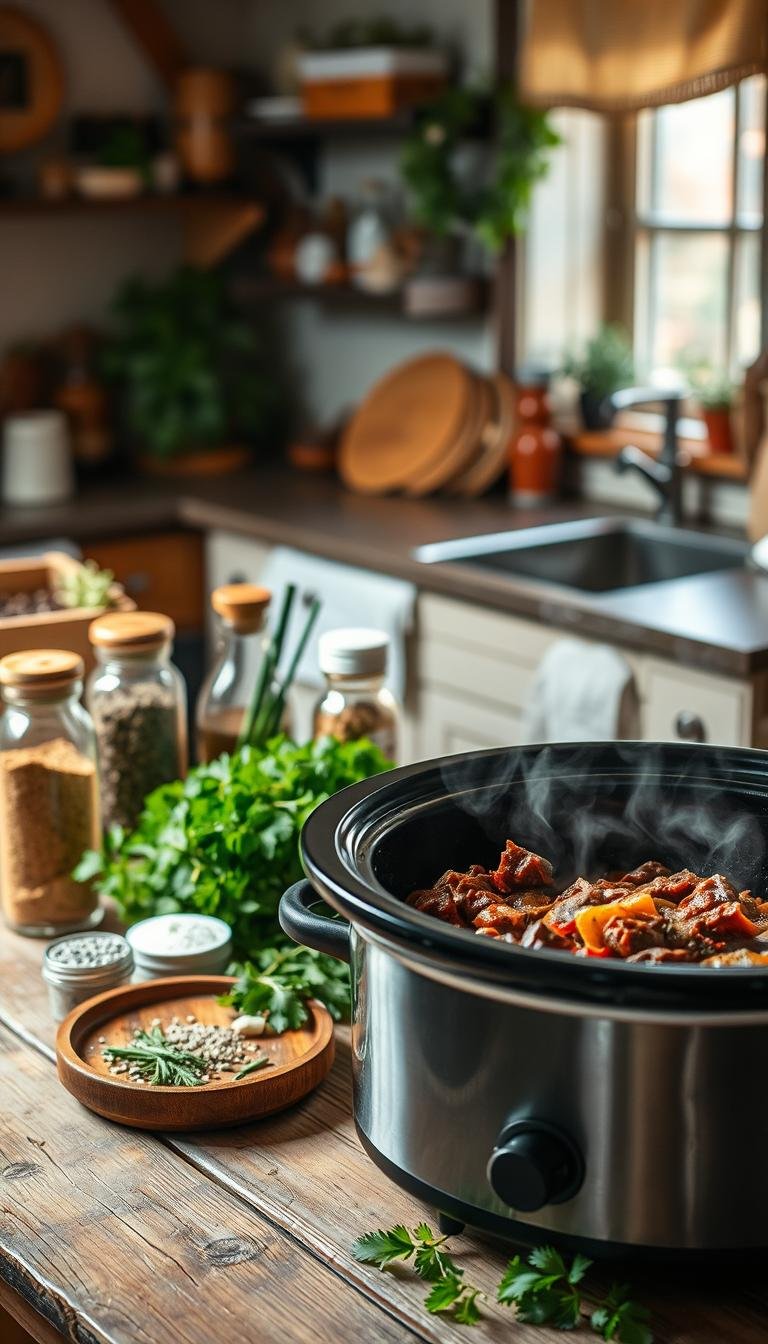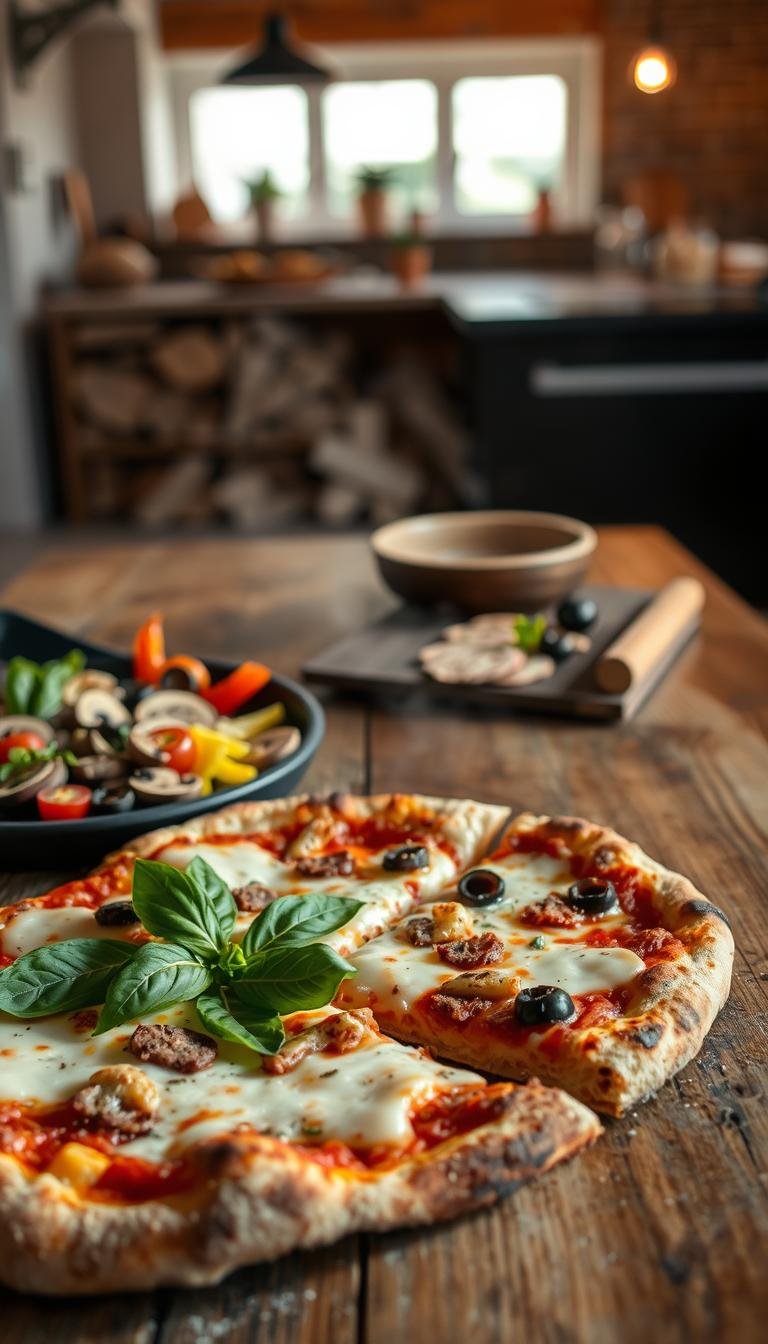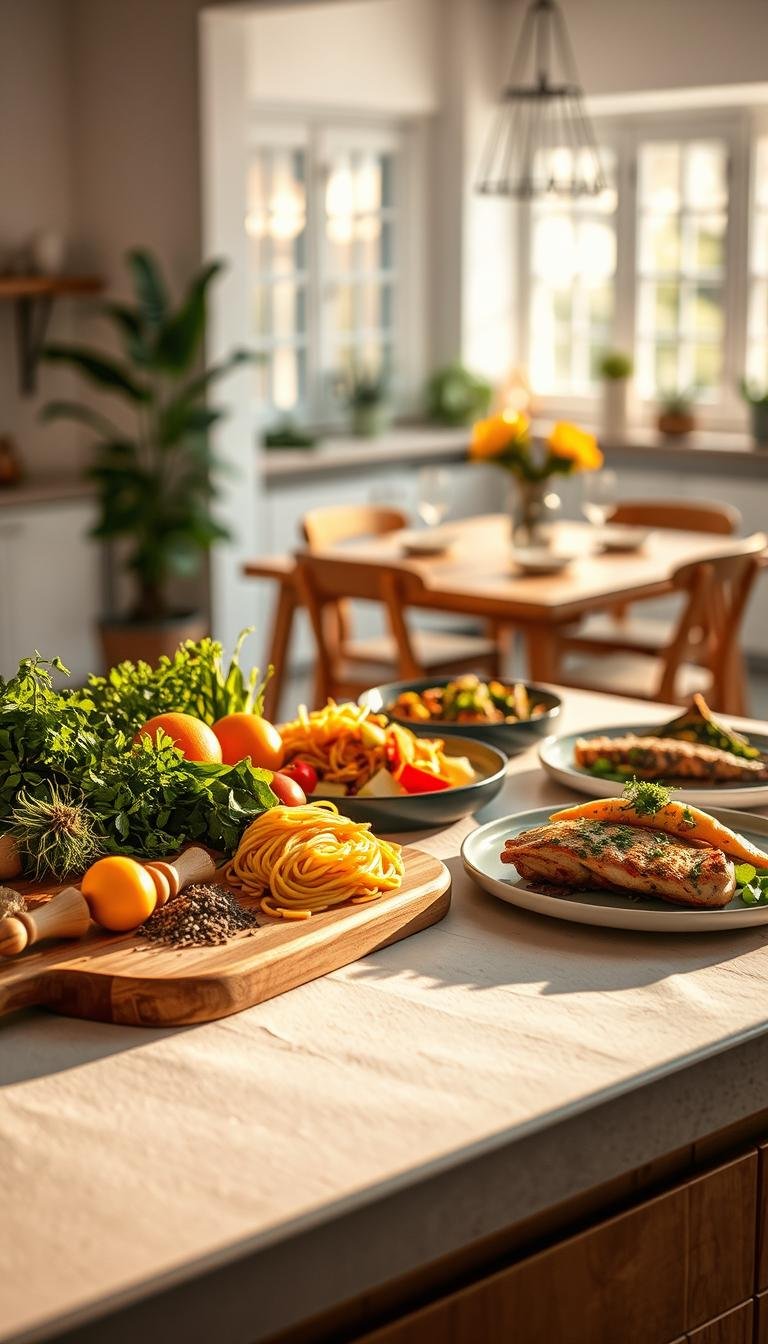Crockpot Recipes Beef: Simple & Delicious Dinner Recipes
Surprising fact: more than half of home cooks say a single slow-cooked meal saves them two hours a week.
Welcome to a practical guide that turns tougher cuts into tender, flavorful dinners with minimal fuss. You’ll learn quick timing cues — like 3½–4 hours for takeout-style Beef & Broccoli, 8–10 hours for a hearty stew, and 7–9 hours for shredding a chuck roast.
We focus on pantry stars such as soy sauce, Worcestershire, tomato paste, and low-sodium broth. These build deep flavor fast in a cooker without extra steps.
Find easy tips for sequencing vegetables so they stay bright, and simple methods to thicken sauces with a cornstarch slurry. Storage notes help you keep leftovers 3–4 days refrigerated or freeze up to 3 months in juices.
Key Takeaways
- Low and slow turns inexpensive cuts into tender meals with little hands-on time.
- Match the time to the dish: short for broccoli-style, long for stew and shredding.
- Core pantry items add savory depth without extra shopping.
- Add quick-cook veggies near the end to keep texture and color.
- Cool and store safely: refrigerate 3–4 days or freeze up to 3 months.
Easy weeknight slow cooker dinners with beef, right now
A true set‑and‑forget meal starts with simple ingredients and a reliable pot on the counter. Spend five active minutes in the morning for dump‑and‑go shredded beef, or choose a shorter plan when you need a faster finish.
What “set it and forget it” really looks like on busy days
Define it as minimal prep: add protein, broth, soy, Worcestershire, and seasonings to the cooker in minutes. Turn to cook low hours for shredding (7–9 hours) or cook low for thin‑sliced sirloin meals (3½–4 hours).
Key pantry ingredients to keep on hand
- Keep: low‑sodium beef broth, soy sauce or tamari, Worcestershire, tomato paste, brown sugar.
- Spices: garlic, onion powder, Italian seasoning, paprika, cracked pepper.
- Tools: leave the slow cooker out and stocked so cooking becomes automatic.
Match the day to the timing and you’ll always have a comforting meal full of flavor without last‑minute stress. This simple recipe mindset keeps weeknights calm and dinner reliable.
Slow-Cooker Beef & Broccoli with rich garlic-soy sauce
This slow‑cooker take on beef & broccoli packs bold garlic and soy into an easy, hands‑off dinner. Use 1 1/2 lb thinly sliced sirloin for tenderness or swap chuck if you prefer value.
Ingredients and prep
Measure: combine 1 cup low-sodium beef broth, 1/2 cup low-sodium soy sauce, 1/2 cup brown sugar, 3 Tbsp sesame oil, 1 Tbsp sriracha, 3 minced garlic cloves, and 3 sliced green onions in the cooker.
Slice meat thinly against the grain. If it slips, freeze the steak briefly to make even cuts easier.
Cooking method
Load the steak and sauce into the slow cooker, stir to coat, and cook on low for 3½–4 hours until the meat is tender and infused with umami.
Thickening and finishing
Whisk 2 Tbsp cornstarch into a few tablespoons of hot broth until smooth, then stir back into the pot.
“Bring the sauce to a full boil — that burst of heat activates the cornstarch and gives the sauce body.”
Add 2 cups of 1‑inch broccoli florets and cover. Cook about 20 minutes until broccoli is bright and the sauce thickens.
To serve
Serve over jasmine rice, top with sesame seeds and extra green onions. Leftovers keep 3–4 days refrigerated; reheat gently with a splash of broth if needed.
- Quick tip: Reduce brown sugar if you prefer less sweetness and add a squeeze of lime at the top when plating.
- Swap idea: Use flour (double the amount) dissolved in hot broth if you don’t have cornstarch.
Hearty Crockpot Beef Stew with potatoes, carrots, and red wine
A long, slow simmer with aromatics and red wine builds a stew that tastes like Sunday dinner any night of the week. Start by cubing a 3 lb chuck roast, seasoning with salt, pepper, and garlic powder, and tossing in 1/2 cup flour.
Flavor-first technique: Brown the flour-coated meat in 4 Tbsp butter in batches to build fond. Deglaze the skillet with 1 cup Cabernet Sauvignon (or swap 1 cup beef broth) and transfer the juices and meat to the pot.
Layer 1 1/2 cups chopped celery, 2 cups chopped carrots, 1 chopped onion, and 2 lb Yukon gold potatoes cut in large pieces over the meat. Stir in 1 Tbsp minced garlic, 6 oz tomato paste, 2 Tbsp Worcestershire, and 3 cups beef broth. Nestle in two bay leaves.
Set the unit to low and cook for 8–10 hours until the meat is meltingly tender. Keep potato and carrot pieces larger so they hold shape during the long, gentle simmer.
Add 1 1/2 cups frozen peas in the last 15–20 minutes for a bright finish, then ladle into bowls and pass warm crusty bread. Leftovers reheat beautifully and make a comforting pot pie.
“Start flavor-first by coating the meat, browning to build fond, and deglazing with wine to capture every caramelized bit.”
- Season carefully—salt, pepper, onion and garlic powder, and paprika—to balance concentrated flavors before serving.
- Swap the wine for beef broth if you prefer no alcohol; the result remains richly satisfying.
Dump-and-go Slow Cooker Shredded Beef for meal prep
This dump-and-go plan turns inexpensive cuts into pull-apart meat that shines across plates. Add a 3–4 lb chuck roast to the cooker with 1 cup beef broth, 2 Tbsp soy sauce, 2 Tbsp Worcestershire, and 1/4 cup optional red wine.
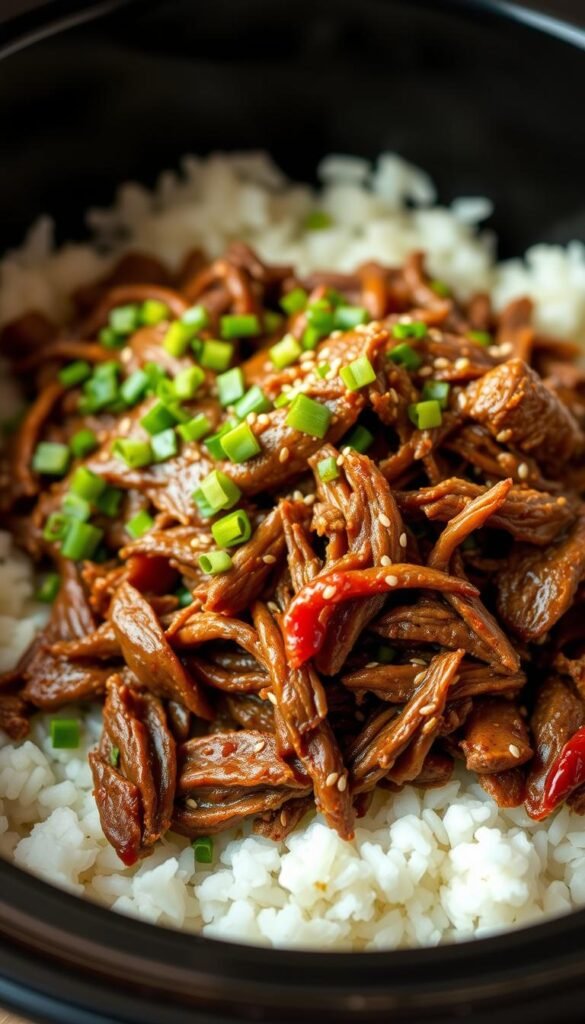
Best cuts and simple seasoning
Choose a well-marbled chuck for the most tender result; round or rump work as backups.
Season with 2–3 minced garlic cloves, 1 tsp Italian seasoning, 1/4 tsp onion powder, 1/2 tsp cracked pepper, and 1/2–3/4 tsp sea salt.
Hands-off method
Add everything to the slow cooker and set to cook low. It needs 7–9 hours until the roast falls apart easily.
Shred right in the pot or on a board, then return meat to its juices to stay juicy while you finish sides.
Finish, serve, and store
For a saucier sauce, whisk 2–3 Tbsp cornstarch into 1/2–2/3 cup hot broth and stir back in to thicken. Serve over mashed potatoes, wide noodles, or pile into tacos, sandwiches, or nachos.
Store refrigerated 3–4 days or freeze in juices up to 3 months for quick future meals.
| Item | Amount | Purpose |
|---|---|---|
| Chuck roast | 3–4 lb | Main shreddable cut |
| Beef broth | 1 cup | Moisture and flavor base |
| Soy + Worcestershire | 2 Tbsp each | Umami builders |
| Garlic & spices | As listed | Seasoning balance |
“Let time do the work: low heat turns tough meat into tender, ready-to-use pulled beef.”
crockpot recipes beef
Choosing the right cut makes the difference between a silky, saucy dinner and a dry, overcooked meal.
Choosing the right cut: sirloin vs chuck roast vs stew meat
Sirloin works best for thin slices that cook quickly and stay tender in saucy dishes like beef-and-broccoli styles. Plan about 3½–4 hours on low for these thin cuts.
Chuck roast shines when you want shreddable, juicy strands. Its marbling melts during a long cook, so schedule 7–9 hours on low for pull-apart texture.
Stew meat is convenient but can be variable in quality. Treat it like a slow project: expect the full 8–10 hours on low to reach fork-tender doneness.
Low slow vs hours high: when to use each setting
Opt for low slow for reliable tenderness. Low preserves collagen breakdown and keeps edges from tightening.
Use hours high only for smaller loads or when you can watch doneness closely. High speeds the cook but can make large roasts tough.
- Trim excess surface fat but keep intramuscular marbling for flavor.
- Make chunks uniform so everything finishes evenly.
- Season at the start and taste-adjust at the end — long cooking dilutes salt and spice.
| Cut | Best use | Typical time on low |
|---|---|---|
| Sirloin | Thin slices in saucy dishes | 3½–4 hours |
| Chuck roast | Shredding, pulled meat | 7–9 hours |
| Stew meat | Cubes for stew | 8–10 hours |
“Match the cut to the method: thin cuts for quick saucy cooks, whole roasts for long, low pulls, and cubes for slow stews.”
Ingredients and smart substitutions to match your pantry
A few smart staples let you swap freely and still finish with deep, layered flavor. Keep basics that add body and let you adapt any slow dinner to what’s on hand.
Broth and wine: Store low-sodium beef broth to control salt. Use it 1:1 in place of red wine when you prefer no alcohol. For richer notes, choose Cabernet or Pinot Noir; if you skip wine, boost Worcestershire or tomato paste a touch.
Alliums and aromatics: Fresh garlic and sliced green onions brighten dishes. Use garlic powder or onion powder when fresh options aren’t available. Whole cloves add a warm lift in stews if desired.
Sauce builders and veg timing
Combine soy or tamari, Worcestershire, tomato paste, and a pinch of brown sugar to round the sauce. Add sturdy vegetables like potatoes, carrots, celery, and onions early so they hold shape.
Save broccoli and peas for the last 15–20 minutes for color and texture. For thickening, slurry cornstarch in hot liquid; if you use flour, double the amount and whisk smooth before adding.
| Pantry item | Swap option | Use |
|---|---|---|
| Beef broth | Red wine | Body, deglazing |
| Soy sauce | Tamari | Umami, gluten-free |
| Cornstarch | Flour (x2) | Thicken sauce |
“Adjust seasoning at the end—long cooks tame salt and heat, so finish with a small pinch of salt and pepper for bright flavor.”
Cook times, temperatures, and how to know beef is done
Match the clock to the cut: long low cooks soften collagen, short low cooks keep thin slices tender. Planning time up front avoids overcooking and keeps texture consistent across dishes.
Timing guide and settings
Use time bands: 8–10 hours on low for a rich stew, 7–9 hours on low for shredding a chuck roast, and 3½–4 hours on low for thinly sliced meat in saucy dishes (plus about 20 minutes to finish broccoli).
How to judge doneness
Shredded meat should fall apart under gentle pressure; that is your cue to stop cooking. Stew cubes should be fork‑tender with no resistance.
- If meat is still tough at the minimum time, keep the cooker on low. Collagen needs slow, steady hours to break down.
- Prefer chuck roast for pull‑apart results; stew meat may need the full low window to reach fork‑tender.
- Aim for enough broth to submerge most of the meat so it cooks evenly and stays moist.
Resist opening the lid early — each peek can add 20–30 minutes to total time. Track your cooker’s quirks so you can fine‑tune start times for your schedule.
“Whisk cornstarch into a few tablespoons of hot liquid, stir into the pot, and bring to a full boil to activate and clarify the sauce.”
Serving, topping, and side ideas to finish your meal
Finish strong by pairing your slow-cooked main with sides and toppings that soak up sauce, add crunch, and lift the overall flavor.
Grain and starch pairings: Spoon saucy Beef & Broccoli over steamed jasmine rice so each bite soaks up every drop. Mound shredded beef over creamy mashed potatoes or toss with wide egg noodles for instant comfort in minutes. Pair a hearty stew with a warm baguette or crusty bread to swipe through rich broth and tender carrots and potatoes.
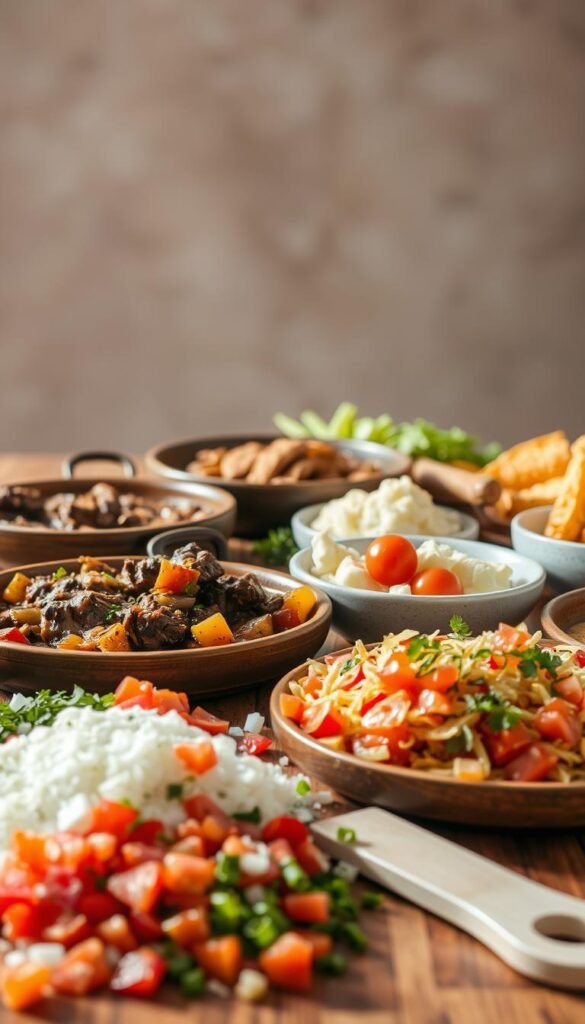
- Spoon saucy beef-and-broccoli over jasmine rice; top with sesame seeds and sliced green onions for crunch.
- Serve shredded meat on mashed potatoes, egg noodles, or in tacos and sandwiches for versatile dinner options.
- Build bowls with rice or potatoes, steamed carrots or broccoli, and a ladle of sauce to balance textures and flavor.
- Offer a toppings bar—cilantro, pickled onions, shredded cheese, lime wedges, sriracha, and sesame oil—so guests can customize their pot at the table.
| Dish | Best pairing | Finishing touches |
|---|---|---|
| Beef & Broccoli | Jasmine rice | Sesame seeds, green onions |
| Hearty stew | Baguette or crusty bread | Butter, fresh parsley |
| Shredded beef | Mashed potatoes / Egg noodles | Lime, cilantro, pickled onions |
“Keep a warm pot on the table and a small toppings bar so every plate gets a personal finish.”
Flavor boosters and sauces that make beef shine
The right mix of savory, sweet, and heat turns simple ingredients into a memorable sauce. Start with a savory backbone: soy or tamari paired with Worcestershire creates deep umami and body.
Balancing savory, sweet, and heat: add a touch of brown sugar for roundness and a squeeze of sriracha for controlled heat. A little sesame oil or olive oil at the end adds aroma.
Building body with tomato paste and thickeners
Tomato paste brings richness and umami, especially for stew and shredded dishes. Stir it into the base early so it can caramelize and deepen.
Thicken with a cornstarch slurry: whisk cornstarch into hot liquid, stir in, and bring to a full boil to activate. For flour, double the amount, whisk smooth in hot broth, then add slowly to avoid lumps.
Finishing touches and practical tips
Add minced garlic and a light sprinkle of onion powder to round sharp edges. Taste at the end and balance with salt, acid (a splash of red wine or lime), or a pinch of sugar.
Use Cabernet Sauvignon or Pinot Noir to layer complexity; swap equal parts broth if you skip wine. Finish off‑heat with a drizzle of sesame oil for extra aroma, and let the sauce rest a few minutes before serving over potatoes or noodles.
“Bring cornstarch-thickened sauces to a full boil — that burst of heat activates the starch and gives the sauce body.”
Storage, reheating, and leftovers that taste better the next day
Proper storage turns tonight’s dinner into an even better lunch tomorrow. Follow a few simple steps to keep texture and flavor, whether you have shredded meat, a rich stew, or saucy stir‑style leftovers.
Refrigeration: Refrigerate cooked dishes in airtight containers within two hours. Keep most dishes 3-4 days in the fridge and store with cooking juices to preserve moisture.
Quick freezing tips
Cool completely before freezing. Portion into labeled containers and pack with enough juices or broth so the meat won’t dry out.
Freeze up to 3 months for best quality. Thaw in the fridge overnight before reheating.
Smart reheating and leftover ideas
Reheat gently on the stovetop or in the microwave with a splash of broth or water and stir every few minutes to heat evenly.
- Turn stew into a quick pot pie: top with puff pastry or biscuits and bake until golden.
- Build bowls with rice or potatoes, reheated meat, quick veg, and fresh herbs.
- Use shredded beef in quesadillas or grilled sandwiches; boost flavor with a pinch of garlic powder or onion powder and a little salt if needed.
“If sauces tighten after chilling, whisk 2–3 Tbsp cornstarch into 1/2–2/3 cup hot juices and stir in to restore body.”
Conclusion
Match time and cut, and weeknight dinner plans become simple. Use the three core approaches — quick saucy bowls in 3½–4 hours, shredded chuck roast in 7–9 hours, or a rich stew in 8–10 hours — to fit your schedule.
Keep a short pantry list: low‑sodium broth, soy or tamari, Worcestershire, tomato paste, and a splash of red wine or broth swap. These ingredients unlock deep flavor with minimal prep.
Serve over rice, noodles, or potatoes and top with fresh herbs for contrast. Store leftovers 3–4 days or freeze in juices up to 3 months. Keep notes on your cooker and seasonings so every future cook repeats success with less effort — a strong, repeatable recipe for cozy meals.
